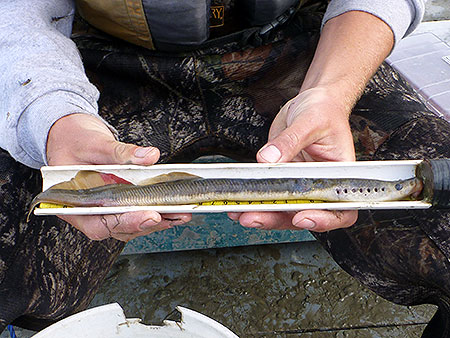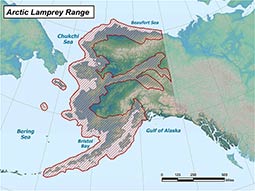Arctic Lamprey
(Lethenteron camtschaticum)
Species Profile
Did You Know?
Female lamprey may spawn with more than one male and can produce as many as 100,000 within a few weeks.
General Description
The Arctic lamprey is a small eel-like fish up to 24 inches in total length though the freshwater resident form rarely exceeds seven-and-a-half inches. Arctic lampreys are distinguished from other Alaska lampreys by two large teeth on the supraoral bar and the presence of a row of posterial teeth.
Adult Arctic lampreys are blue-black to dark brown on the dorsal side and yellow to light brown on the ventral side with light tan to gray fins. Adult Arctic lampreys have a dark blotch on the posterior dorsal fin and the tail. The body of juvenile Arctic lamprey is usually gray above and lighter below. The anal fin of the female Arctic lamprey is noticeably larger than that of a male, while female Arctic lampreys lack urogenital papilla.
Life History
Growth and Reproduction
Arctic lampreys have two different ecotypes, or different life history strategies, regarding their feeding habits and migration behavior: an anadromous, or sea-run, predatory form and a freshwater form with a non-feeding adult (currently referred to as a separate species, the Alaskan brook lamprey). Arctic lamprey are anadromous, which means it spends its juvenile life feeding and growing in the ocean and its larval and adult stages of its life in freshwater. In large rivers such as the Yukon River, anadromous Arctic lampreys spend months moving to the cool, clear headwaters of streams to make their nest. Freshwater resident Alaskan brook lampreys perform much shorter migrations before building nests and spawning. Spawning primarily occurs in May and June but reports also suggest spawning occurs into July and August, depending on the location.
Both males and females participate in nest building by removing small rocks with their mouths and cleaning sands and gravels by rapidly fanning their tails. Males and females intertwine while simultaneously depositing sperm and eggs into their nest. Depending on her size, a female can release up to 100,000 eggs. The adults die soon after egg fertilization. The eggs hatch into larvae in 7 to 14 days, depending on the water temperature. A couple weeks later, the larvae emerge from the nest and drift in the current until they settle into low velocity habitats such as eddies and pools. Larval forms of lampreys have no eyes and lack sucking mouthparts. Lampreys remain at this stage for three to seven years before metamorphosing into juveniles, which includes the feeding stage of their life cycle, involving the development of eyes and a toothsome, suction mouth.
Feeding Ecology
Larvae burrow into the silt or mud of shallow pools and eddies of clear streams and feed by filtering primarily detritus from the water. Anadromous juvenile Arctic lampreys are considered predatory and feed on other species of fish (e.g., juvenile Pacific salmon, capelin, and Pacific herring) by using their sucking mouthparts to attach themselves to fish and tearing off chunks of flesh, fin, and bone. Once returned to freshwater, adults migrating upstream do not feed.
The freshwater resident form of Arctic lamprey (currently referred to as the Alaska Brook Lamprey) feeds similarly as larvae but upon metamorphosis and despite a suction mouth and teeth, enters a non-feeding adult stage before spawning and dying.
Migration
Juvenile Arctic lampreys migrate to the sea in spring time after metamorphosing the previous summer and tend to spend one to four years in the marine environment before returning to freshwater to spawn. Some anadromous lampreys, such as Arctic lamprey in the Yukon and Kuskokwim rivers, return to freshwater in the fall and overwinter until spring when they spawn. Other anadromous lampreys return to freshwater and spawn in summer though it is unclear to what extent this occurs in Arctic lamprey. Lampreys tend to migrate upstream in groups.
Range and Habitat
In Alaska, Arctic lampreys are found from the Kenai Peninsula north along Bering Sea drainages and east along the Arctic coast to the Anderson River. Arctic lampreys also occur in the Yukon, Kuskokwim, and Tanana river drainages and around St. Lawrence Island.
Status, Trends, and Threats
Status
Arctic lamprey, along with all Alaska lamprey species, are considered a Species of Greater Conservation Need (PDF 17,981 kB) by the Alaska Department of Fish & Game. Population discreteness for Arctic lampreys within and among river systems in Alaska is unknown, as very little information exists on Arctic lampreys in general. An understanding of Arctic lamprey population genetic structure is necessary to identify appropriate management units.
Trends
Overall strength of Arctic lamprey returns varies across the state by year and location. Why run strength remains strong in some areas while weak in other areas is unclear. No population baseline exists for any lamprey species in Alaska.
Threats
Potential overharvest from commercial, personal use or subsistence fisheries is the main threat to the resource. Predation by invasive Northern Pike in the Susitna River drainage is a potential threat to populations of Arctic Lamprey in Southcentral Alaska.
Fast Facts
-
Size
The Arctic lamprey can grow up to 24 inches but is generally smaller and the freshwater resident form rarely exceeds seven-and-a-half inches. -
Range/Distribution
From the Cook Inlet side of the Kenai Peninsula north along Bering Sea drainages and east along Arctic Ocean drainage as far as the Anderson River. -
Diet
Juveniles are filter feeders of microorganisms and organic matter from the sediment. Adults are known to be predatory, feeding upon juvenile salmon, capelin, and herring in nearshore marine habitats of Alaska. -
Predators
In marine environments, beluga whales and large fishes are likely predators of juvenile Arctic lamprey. In freshwater, larvae, juveniles, and adults are eaten by a variety of fishes, birds, mink, and river otters. -
Reproduction
Female Arctic lamprey can produce up to 100,000 eggs and die after spawning. -
Remarks
Managed as a commercial fishery in the Yukon and Kuskokwim rivers by the Alaska Department of Fish & Game.


